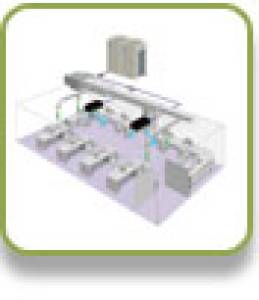Description
VRV & VRF Systems: Advanced Climate Control Solutions
Transform your space with the ultimate in climate comfort and efficiency. VRV (Variable Refrigerant Volume) and VRF (Variable Refrigerant Flow) systems represent the pinnacle of HVAC technology, offering unparalleled control, flexibility, and energy savings. While often used interchangeably, there are subtle differences. This description covers both, highlighting their key features and benefits.
What are VRV and VRF Systems?
VRV and VRF systems are advanced air conditioning and heating systems that utilize a single outdoor unit connected to multiple indoor units. Unlike traditional HVAC systems, these systems offer individual zone control, allowing you to adjust the temperature in different areas of a building independently. This precise control leads to significant energy savings and enhanced comfort.
Key Differences:
While both systems share the core principle of variable refrigerant flow, the main difference lies in the manufacturer:
- VRV: This is a trademark of Daikin Industries, referring specifically to their range of variable refrigerant volume systems.
- VRF: This is a more general term encompassing various manufacturers' systems that operate on the same variable refrigerant flow principle. Therefore, VRV can be considered a type of VRF system.
Benefits of VRV/VRF Systems:
- Zone Control: Independent temperature control for each room or area, optimizing comfort and energy efficiency.
- Energy Efficiency: Precise control minimizes energy waste, leading to lower operating costs and a smaller carbon footprint. Variable speed compressors adjust output based on demand, unlike traditional on/off systems.
- Flexibility: Suitable for a wide range of building types and sizes, from small offices to large commercial spaces. Easily adaptable to future expansion needs.
- Quiet Operation: Advanced technology minimizes noise pollution, creating a more peaceful environment.
- Improved Air Quality: Some systems incorporate features like filtration and ventilation, improving indoor air quality.
- Space Saving: The compact outdoor unit design requires less space compared to multiple individual systems.
- Scalability: Easily expandable to accommodate future growth or changes in occupancy.
- Remote Monitoring & Control: Many systems offer advanced control options through smartphone apps or building management systems (BMS), allowing for remote monitoring and adjustments.
Applications:
VRV/VRF systems are ideal for various applications, including:
- Offices: Create customized climate zones for individual offices or departments.
- Retail Spaces: Maintain consistent temperature throughout the store while minimizing energy consumption.
- Hotels: Provide individual climate control for each guest room, enhancing comfort and guest satisfaction.
- Hospitals: Ensure precise temperature regulation in different areas, such as operating rooms and patient rooms.
- Residential Buildings: Offer superior comfort and energy efficiency in large or multi-zone homes.
System Components:
A typical VRV/VRF system consists of:
- Outdoor Unit: Houses the compressor, condenser, and refrigerant circuits.
- Indoor Units: Multiple indoor units (cassette, ceiling-concealed, wall-mounted, floor-standing, etc.) provide heating and cooling to individual zones.
- Refrigerant Piping: Connects the outdoor and indoor units, transporting the refrigerant.
- Control System: Manages the operation of the system, allowing for individual zone control and monitoring.
Choosing the Right System:
Selecting the right VRV/VRF system depends on various factors, including:
- Building size and layout: The capacity and configuration of the system must match the building's needs.
- Cooling and heating requirements: The system must be capable of meeting the heating and cooling demands of each zone.
- Budget: The initial cost and ongoing operating costs must be considered.
- Energy efficiency requirements: Select a system with high SEER (Seasonal Energy Efficiency Ratio) and HSPF (Heating Seasonal Performance Factor) ratings.
Contact us today for a consultation to determine the best VRV/VRF system for your specific needs.
